Lehigh Valley Tours
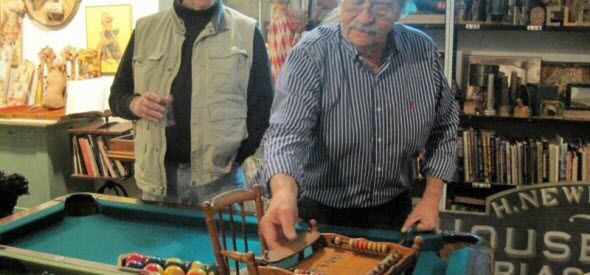
We were discouraged by neither the tropical storm warnings nor the twisting back roads of rural Pennsylvania – the two intense days of tours were superb! We had chosen to meet around the Allentown Paper Show (that sprawling cornucopia of the full range of paper collecting, on the same campus as a world-class farmers market) but Barbara Charles discovered several surprising touring opportunities (and both she and President Nancy Rosin visited beforehand to prepare). Barbara also scoped interesting restaurants (scotch eggs, anyone?).
The Moravians, a pre-Luther Protestant sect, settled Bethlehem in 1741 and the very next year set aside a room in their main communal building for an archive. This piotist group believed in daily recording their spiritual history – which, perforce, included much of interest from the wider experience of colonial America and then the early republic. Binding coverings of paste paper were a craft unique to Moravians (see below: there is a resemblance to marbled paper):
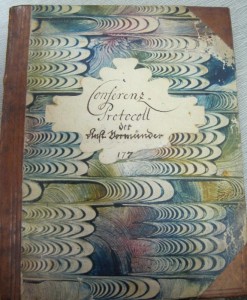
Their successful communal living (many of the handsome buildings remain in both Bethlehem and Nazareth) gave way to private households but the church still directed businesses. And, for several generations, women (who were ordained in the 1700s) wore bonnet ribbons in colors to indicate their marital status (see below: pink for single, blue for married, white for widowed).
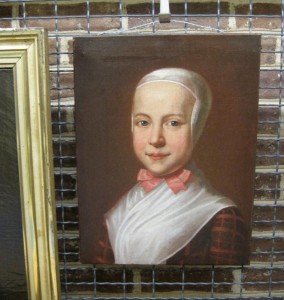
Director Paul Peucker (see below), who came to the Bethlehem museum (a modern building completed 1977) from the Moravian main community in Herrnhut, Germany, in 2004 has been cataloging the original library (one third of which was not listed in WorldCat) and creating finding aids for the Moravian papers that have been sent to Bethlehem for safety.
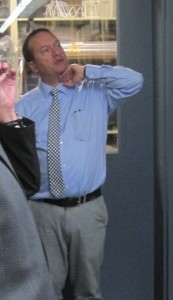
Director Paul Peucker (left), who came to the Bethlehem museum (a modern building completed 1977) from the Moravian main community in Herrnhut, Germany, in 2004 has been cataloging the original library (one third of which was not listed in WorldCat) and creating finding aids for the Moravian papers that have been sent to Bethlehem for safety.
In Nazareth, the historical society of the twin Moravian communities is housed in a very handsome stone communal building from 1740. Although their displays feature furniture, musical instruments, etc. to interpret early Moravian life (with documentation if possible – here is an 1870 sketch of the installation of a Moravian-designed pre-1776 parlor stove that is still in the upstairs meeting room), Derek Clark had brought out several treasures from their paper and bibliographic holdings.
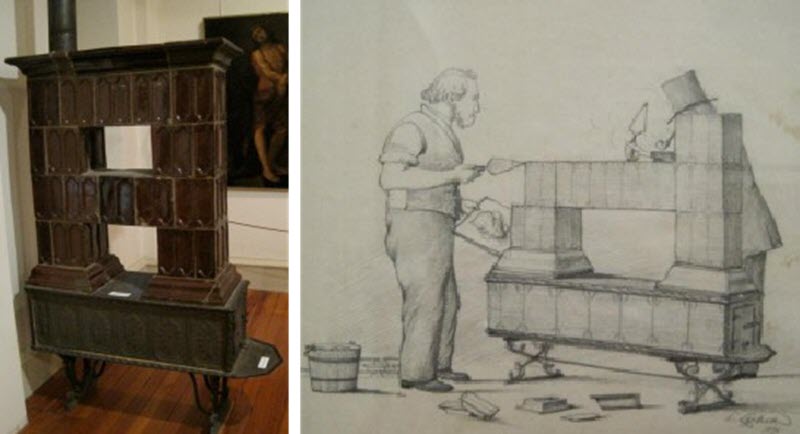
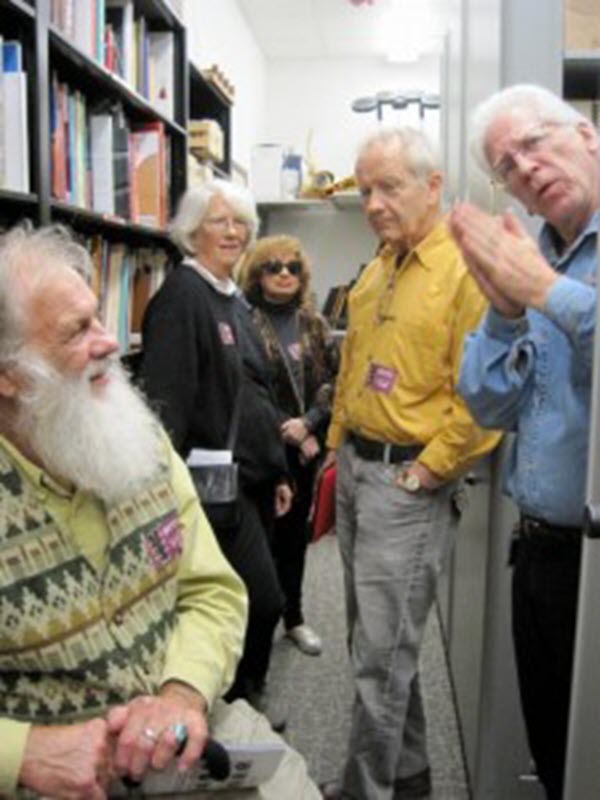
Also in Nazareth, the Martin Guitar Factory, established in 1833, is the longest continuously-operating company in the country. The factory tour that they offer is stellar – our guide Bobbie (see below, explaining the origin of the fine woods used for Martin instruments) was entertaining and knowledgeable, and we truly were able to glimpse at close quarters almost all of the 100+ hands-on and machine operations that go into making even the simplest of Martin guitars. Their instrument strings are now made in Mexico but tested here. The director of their museum, archives, and special projects, Dick Boak (see at right with, from left, Robert Dalton Harris, Barbara Charles, Barbara Rusch, David Freund) who has worked for the company for 39 years, treated us to a behind the scenes tour of the company documentation and a personal tour of the museum that he lobbied for and helped create. He opened cases and took down rare and expensive guitars to play them for us – including the first guitar that C.F. Martin made in America (from Markneukirchen, German Martin set up in New York City in 1833, and moved in 1838 to Nazareth to set up among the Moravians who were known as fine woodworkers), and a powerful concert model (see below).
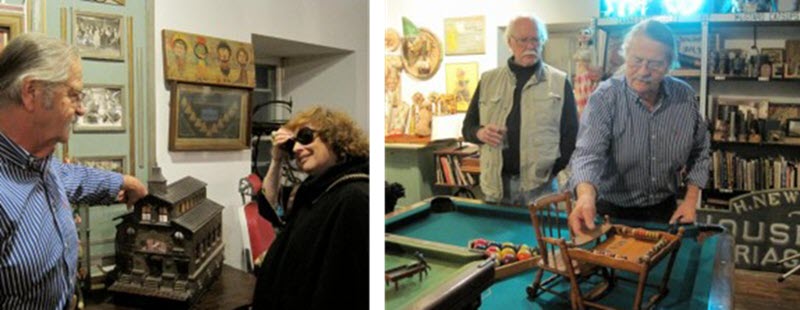
Who would have thought a vast steel mill would be ephemeral? Certainly not Don Trexler, third-generation steelworker of 33 years; not Susan Vitez, a third-generation employee of Bethlehem Steel; nor even Dale Kochard, who is too young to have worked for “The Steel” but delivered lunches to his father, a second-generation employee. After Bethlehem Steel stopped pouring in 1995 and failed altogether in 1998, a consortium of interests made it possible for the employees to organize a Steelworkers Archives, and to give tours of the site (as well as to develop the site as a multi-faceted event campus). Susan, who is program director, described the archives and Don gave us a wonderful, personal, talk about the rise and fall of steel in the Lehigh Valley (see below). They then took us on a wet and windswept site tour (a couple of days later in the sunshine, Oktoberfest drew crowds of locals and tourists – see below). Dale, who is President of the Friends of Saint Michaels Cemetery in South Bethlehem, gave us a talk (at Arts Quest) about the cemetery and its most iconic image by Walker Evans (see below).
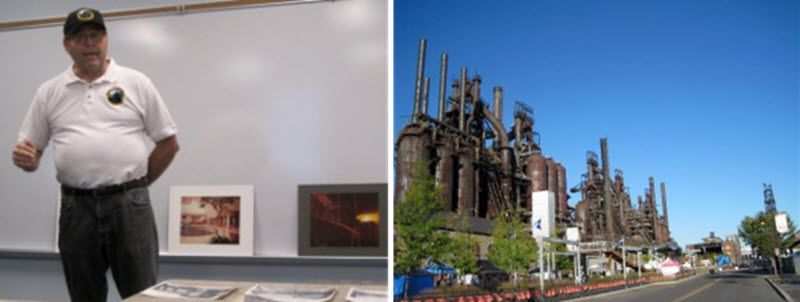
All of our Ephemera Society tours are open to the general membership. But Noel Barrett invited just the Board Members and spouses to a special evening opportunity to see his extraordinary antique toy collection in nearby Carversville. Many of you would recognize Noel from his voluntary presence on The Antique Road Show. And all of you would have loved to hear his avid-collector-tales. See Noel below with Barbara Rusch of Toronto, Canada, and with Glenn Mason of Portland, Oregon.
